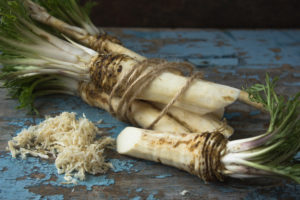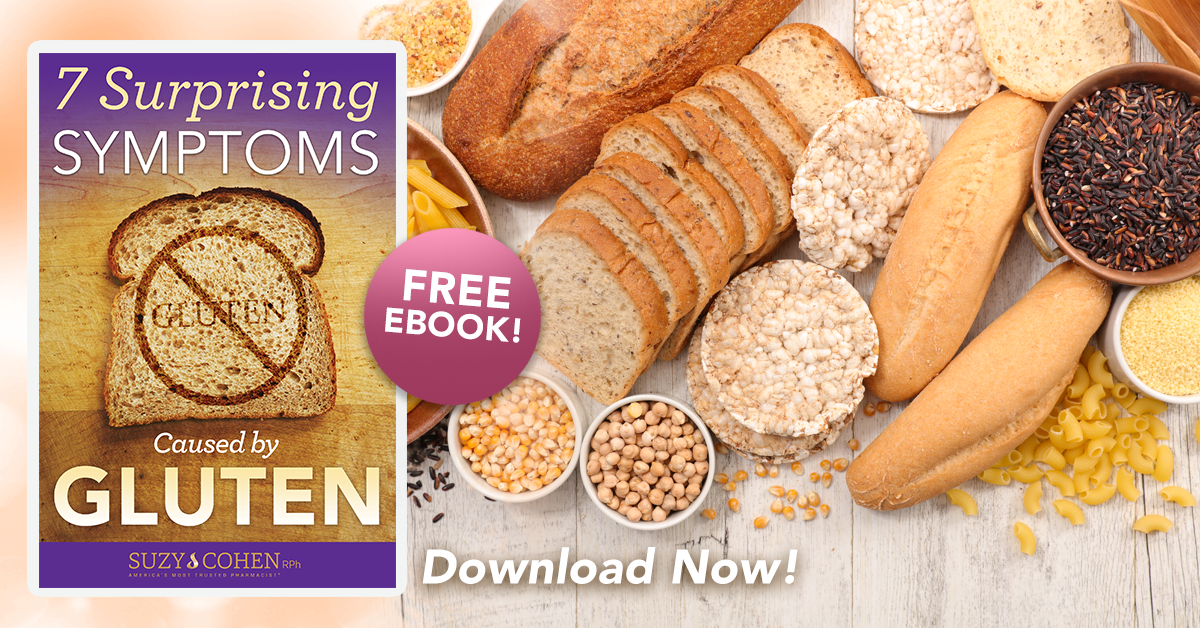What's On This Page?
ToggleI went to a local Polish German restaurant the other day and as I was eating the beet horseradish with the corn beef, I had to blow my nose, and then my mind wandered… What causes the zingy ‘burn’ sensation that so quickly clears my sinuses, lol?! What is this stuff? 😅
Fun fact, horseradish has nothing to do with horses, or radishes. It’s a root that grows best in cold weather and has been cultivated for over 2,000 years! It comes from a perennial (returning) plant from the Brassica family that also includes wasabi, mustard, cabbage, radishes, Swiss chard, broccoli, bok choy and arugula.
Horseradish (Armoracia rusticana) has a few critical minerals like zinc, calcium, magnesium and potassium. It also has natural folate and vitamin C. But the condiment has a pungent flavor thanks to “sinigrin.” That is a glucosinolate found in other foods and condiments, but horseradish has a ton of it!
You may not have heard of sinigrin but you’ve certainly tasted it before because it naturally occurs in other foods and condiments such as wasabi, mustard, and the cruciferous veggies like Brussels sprouts, kale and broccoli. The sinigrin converts naturally to form this other compound called “allyl isothiocyanate” which is abbreviated AITC.

You might assume that AITC is only available in foods, but it’s not. Producers have figured out a way to make synthetic AITC in a lab! They use it in huge quantities as pest control when growing crops. That makes sense if you think about it! Bugs will run in the presence of this chemical.
There are medical benefits to natural horseradish, so if you like it, eat it every now and then. It’s not possible to eat enough in one sitting to make any kind of nutritional dent so don’t go off your medicine for any of the following problems.
These are the 4 BEST pharmacological activities for Horseradish:
1. Respiratory problems.
You knew this already! If you have bronchitis, a mild cough, or sinus congestion, the horseradish will temporarily clear that up and help with drainage. Horseradish is often used holistically as a natural adjunctive treatment for asthma and hayfever. With a bio like that, I’d say horseradish can modestly reduce risk for pneumonia if you have a bad flu, simply by eliminating mucus from the lungs. As you probably know, the zingy stuff will make your nose run instantly helping a stuffy nose!
2. Fluid retention May Be Positively Impacted by Horseradish.
The sinigrin in horseradish increases blood circulation in the body. It stimulates your capillaries to open and can help with foot edema and fluid retention. Horseradish is known to promote urination and therefore it has a mild diuretic effect. This is great if you have mild hypertension, but by no means is it a substitute for medication. It can help as a natural remedy for some urinary tract infections
3. Digestion.
There are holistic practitioners that know horseradish helps normalize bowel movements and therefore might help with constipation by stimulating peristalsis. There is some research that suggests it can help with intestinal worms.
4. Tumor Growth.
There is some research that suggests liver cancer spread may be slowed in the presence of sinigrin. Slowing metastasis down is important. I read an interesting PAPER from 2009 about the potent tumor-suppressing activity of AITC in animals. This was an animal study, not human. And as a reminder, AITC is not just found in horseradish, you find it in cruciferous vegetables as well!
In 2010, there was another study that proved AITC beneficial “as a cancer chemopreventive phytochemical.” And finally, in this paper from Carcinogenesis 2010 searchers concluded that AITC “is a multi-targeted agent against bladder cancer… and potently inhibits bladder cancer development and invasion.” Horseradish is a strong anti-inflammatory food. It inhibits COX, LOX and prostaglandins. It lessens inflammation and has some antimicrobial activity. In short, it has some useful analgesic activity.
What about Kids, Is it OK for Them?
Little ones like 4 and 5 year olds shouldn’t be eating horseradish. Also, pregnant women should not eat too much because horseradish contains naturally-occurring, irritating compounds and I read that it is associated with miscarriage –> not sure if that’s true but to be safe, avoid it! The same can be said if you are breastfeeding because your baby will not like your breast milk very much. But for everyone else, it’s tasty and healthy, unless of course you have ulcers or kidney damage.
Some people are allergic to horseradish, and they’re not even aware of it until they come into contact with the stuff! It reminds me a little bit of stevia. I wrote an article that might interest you called, The Surprising Connection Between Stevia and Ragweed.
One simple way to incorporate horseradish is to put it on top of your hamburger or a roast beef sandwich. Traditionally, you see horseradish sauce served with red meat dishes. You can put a dollop on top of roasted vegetables too. I’ve never had a Bloody Mary, but they put horseradish and hot pepper sauce in that drink! I’ll have to try that one day, but only if some Pepcid is handy!
If you don’t want to eat the condiment plain, and find yourself bracing the table as your eyes water, and nose runs, simply cut it down with some mayonnaise, or combine it with grated beets! Either will take down the zing! Here’s my recipe for Creamy Horseradish Sauce that you can use on Prime Rib, or a roast beef sandwich, or even a baked potato.
By the way (and I recently discovered this after 57 years!) you are ‘supposed’ to eat gefilte fish with horseradish! I never knew this! I called my parents and yelled at them right away for never having served it to me this way. 😂 Kidding! Gefilte is not that delectable on its own, it’s SO much better with the horseradish and I’m glad I found this out.
Finally, if you’re curious about freezing horseradish – yes you can, although upon thawing it, you will find that it’s lost some of the pungency. Ideally, you should peel and grate it first, then freeze it in small amounts so you can thaw a small amount at a time, like a serving or two. You can use an ice cube tray. Do you want to read a terrific article on freezing food properly? In light of the times, this is an excellent 5 minutes read: How to Freeze Herbs and Veggies and Why You Should.

Suzy Cohen, has been a licensed pharmacist for over 30 years and believes the best approach to chronic illness is a combination of natural medicine and conventional. She founded her own dietary supplement company specializing in custom-formulas, some of which have patents. With a special focus on functional medicine, thyroid health and drug nutrient depletion, Suzy is the author of several related books including Thyroid Healthy, Drug Muggers, Diabetes Without Drugs, and a nationally syndicated column.



